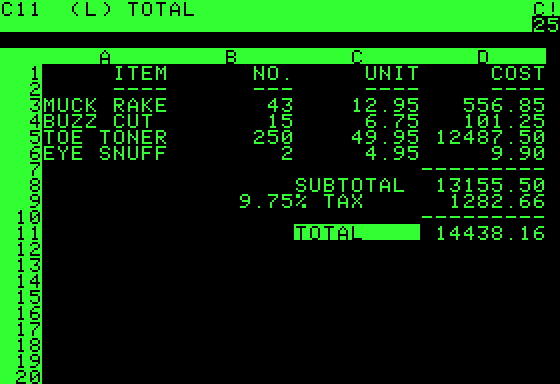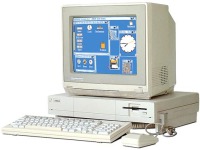
An example VisiCalc spreadsheet on an Apple II
On July 16, 1951, computer scientist Dan Bricklin was born. Together with Bob Frankston he created VisiCalc, the first spreadsheet computer program (1979) which created a market beyond hobbyists for the emerging personal computers. Today, everybody knows spreadsheet programs, no matter if you choose a desktop application or a web based application, spreadsheets are everywhere. And sometimes, we don’t have any idea, how we could possibly get along without them.
Spreadsheets
So, what is a Spreadsheet? A spreadsheet is an interactive computer application program for organization and analysis of data in tabular form. Spreadsheets developed as computerized simulations of paper accounting worksheets. The program operates on data represented as cells of an array, organized in rows and columns. The user of the spreadsheet can make changes in any stored value and observe the effects on calculated values, which is rather useful for “what-if” analysis. In addition to the fundamental operations of arithmetic and mathematical functions, modern spreadsheets provide built-in functions for common financial and statistical operations. But, how did it all start?
Dan Bricklin
It was Dan Bricklin, born in 1951 into a Jewish family in Philadelphia, USA. He earned a Bachelor of Science in electrical engineering and computer science from the Massachusetts Institute of Technology in 1973. Upon graduating from MIT, Bricklin worked for Digital Equipment Corporation (DEC) until 1976, when he began working for FasFax, a cash register manufacturer. In 1977, he returned to school and he earned a Master of Business Administration from Harvard University in 1979. It was in his last year in Harvard Business School, when Bricklin was watching a presentation that gave him the first idea for VisiCalc. The professor was creating a financial model on a blackboard that was ruled with lines to create a table, and formulas and data were being written into the cells. When the professor found an error or wanted to change a parameter, he had to erase and rewrite a number of sequential entries in the table. Bricklin realized that he could replicate the process on a computer using an “electronic spreadsheet” to view results of underlying formulae. Bricklin was joined by Bob Frankston, and the pair worked on VisiCalc for two months during the winter of 1978–79, forming Software Arts.
VisiCalc
Visicalc was first published for the Apple II personal computer. The power of the VisiCalc concept was noticed immediately and for the first 12 months it was only available for the Apple II computer, and became that platform’s killer app. VisiCalc is widely credited for fueling the rapid growth of the personal computer industry. Instead of doing financial projections with manually calculated spreadsheets, and having to recalculate with every single cell in the sheet, VisiCalc allowed the user to change any cell, and have the entire sheet automatically recalculated. This turned 20 hours of work into 15 minutes and allowed for more creativity. In its 1980 review, BYTE wrote “The most exciting and influential piece of software that has been written for any microcomputer application is VisiCalc“. VisiCalc sold over 700,000 copies in six years, and as many as 1 million copies over its history. When Lotus 1-2-3 was launched in 1983, taking full advantage of the expanded memory of the PC and added integrated charting, plotting and database capabilities, VisiCalc sales practically ended overnight. Sales imploded so rapidly that the company was soon insolvent. The next milestone for spreadsheets was the Microsoft Excel spreadsheet. Excel was originally written for the 512K Apple Macintosh in 1984-1985 and was one of the first spreadsheets to use a graphical interface with pull down menus and a point and click capability using a mouse pointing device.
Spreadsheets have even found there way into popular culture. As for example in Douglas Adams novel “Dirk Gently’s Holistic Detective Agency“ he describes a character named Richard MacDuff, a young software engineer. MacDuff is the programmer of a rather popular application called Anthem, which is designed as a spreadsheet, but also has a unique feature to convert corporate accounts into music. I really would appreciate a feature like that 😉
Meet the inventor of the electronic spreadsheet | Dan Bricklin, [9]
References and Further Reading:
- [1] Dan Bricklin’s own VisiCalc Website
- [2] Dan Bricklin: Was VisiCalc the first Spreadsheet?
- [3] D.J. Power: A Brief History of Spreadsheets
- [4] GNU is not UNIX
- [5] Happy Birthday Linux
- [6] Dennis Ritchie – Designer of UNIX and C
- [7] Don’t Panic – Remembering Douglas Adams
- [8] VisiCalc at Wikidata
- [9] Meet the inventor of the electronic spreadsheet | Dan Bricklin, 2017, TED @ youtube
- [10] Timeline of American Cumputer Businesspeople via Wikidata and DBpedia





